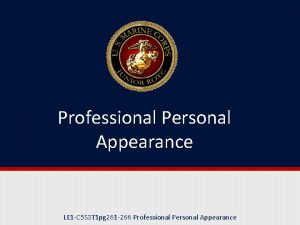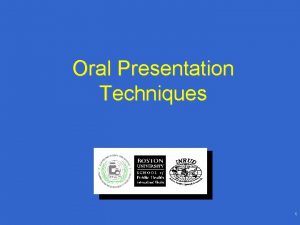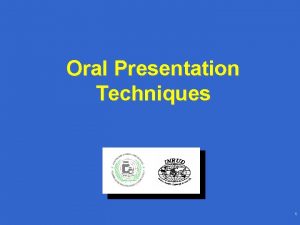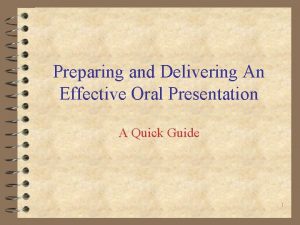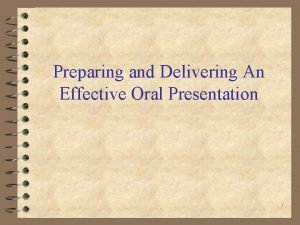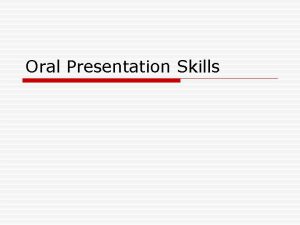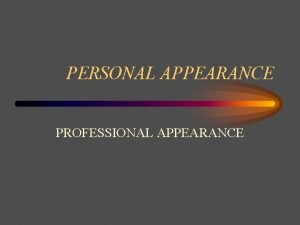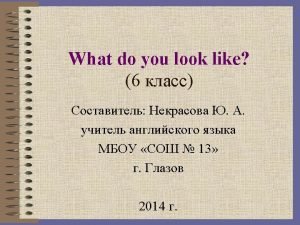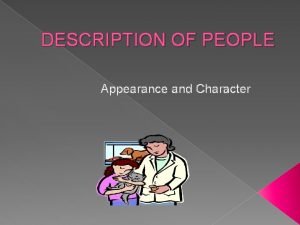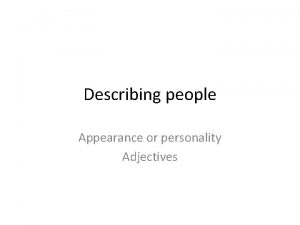PERSONAL PRESENTATION TECHNIQUES Personal Appearance You in the












- Slides: 12

PERSONAL PRESENTATION TECHNIQUES

Personal Appearance ◦ You in the front line ◦ Before you have time to say anything and give an account of yourself, certain assumptions, both consciously and subconsciously, have been made. ◦ First impressions are very important - they can be about attitude as well as appearance. ◦ Visual impact is at least as important as verbal impact, people will very quickly make assumptions based on your facial expressions, the clothes you wear, how well-groomed you are and your body language.

Facial Expressions ◦ However the day started and whatever minor crisis has occurred along the way, people have not come to see you with a dark expression on your face. ◦ It is your duty - to yourself as well as to the organization that you represent - to convey a calm, friendly and professional exterior, despite how you may feel inside. Try to smile and appear optimistic.

Personal Image ◦ The reflection that stares back at you from a mirror is not necessarily a true likeness of the face known to family, friends and colleagues, because they will see you off-guard, in repose, concentrating on a task or listening to them. ◦ How many people can honestly admit to looking in a mirror without altering their expression? ◦ It is quite natural to ‘play to a mirror’ possibly by raising an eyebrow, pulling a face or smiling at the reflection. This is why people often feel self-conscious when they see a ‘bad’ photograph of themselves. ◦ The Real You:

It is human nature to make compromises. All individuals change their approach depending on the people they meet and what they feel is expected from them. Your 'on-duty' self, the one who functions in public, is different from your 'off-duty' self, the one concerned with home, family and friends. Everyone has many and varied roles in life. You can be one person and be a parent, son/daughter, brother/sister, friend, adviser, patient, client and consumer all in one day. These differing roles all require their own particular qualities and skills in personal communication and can also call upon different requirements of attitude and appearance, i. e. , of visual image. Your external image (appearance) is how you are seen by the world, whereas the real you (not a role model or the person you would like to be) is someone who is honest with themselves.

Clothes ◦ What sort of external image is appropriate to the organization you represent? ◦ Only you can answer this question. Due to the nature of the work, some organizations are happy for people to be casually dressed, whilst others may expect smarter attire. It is important to be suitably dressed within expected limits.

Body Language ◦ Understanding body language is one of the most important aspects of personal presentation. The image conveyed by the physical self should support and enhance what is being communicated verbally. If the visual image differs widely from the spoken message, it is often the non-verbal account that is believed. ◦ The way you sit, stand, your gestures and mannerisms and your facial expressions will say far more about you and how you are feeling at any given time than the words you are using. When individuals are nervous or uneasy, their behavioral 'bad habits' become more pronounced.

Positive and Negative body Language ◦ ◦ Positive body language includes: ◦ • Maintaining eye contact with the person you are speaking to. ◦ • Smiling (if appropriate) but especially as a greeting and at the end of a conversation. ◦ • Sitting squarely on a chair, leaning slightly forward (this indicates you are paying attention). ◦ • Nodding in agreement. ◦ • A firm handshake. ◦ • Presenting a calm exterior. ◦ • Looking interested.

Positive and Negative body Language ◦ Negative body language includes: ◦ • Not looking at a person when speaking. ◦ • Tapping a foot, fingers etc. ◦ • Rocking backwards and forwards. ◦ • Scratching. ◦ • Continually clearing your throat. ◦ • Fiddling with hair, ear lobes, jewelry, jacket, glasses, etc. ◦ • Picking at fingers or finger nails. ◦ • Yawning. ◦ • Repeatedly looking at your watch or a clock in the room. ◦ • Standing too close to others. ◦ • Inattention to a person who is speaking.

Interview language Skills ◦ Great interview language skills will help you secure the role. Remember, interviews are a game, and how you look, sound and the words you say are part of that game. When you think about interview language skills, you probably think about the words that are used. This is a natural conclusion but, surprisingly, the words used are a relatively low priority when it comes to communicating at interview (or any other interaction for that matter).

Positive language ◦ For example, replace “I wouldn’t want you to think that I am bad at managing my time” with, “I am a good time manager”. ◦ Make it Sound Like it will Happen and Avoid Weak Qualifiers ◦ You have probably met the “try” or “hopefully” person. “What I’m going to try to do, hopefully, possibly to explain, with a bit of luck, how to be fairly positive, maybe, about this job”. Would you as an interviewer be convinced such people knew what they were talking about, or that you could trust them to be effective in the job? Removing weak qualifiers projects a confident image. Add them and you project an image of uncertainty.

Change the Word ‘but’ to the Word ‘and’ If someone says to you after you have put your case forward, “Yes, but…. ” How are you going to react? It immediately creates a barrier between us. It detracts from what was said. Instead of introducing a negative, you could say, “Yes, and…. ” The difference between an “and” and “but” reply is that I perceive you as adding something and not taking something away from it. This strategy takes time to develop. Once you have developed it, you can go on using it in all interactive situations. Sometimes the simplest tools are also the most powerful! Assume you will Achieve What you Want Rather than saying, “If I was in this role I would…. ” you should say, “When I am in this role I will…. ” By the way you use language you can build in an assumption that you will reach agreement and the job will be yours. Load the language until you reach the point where you and I are talking together about being successful. By your language assume that we are going to do business. Talk about when we’ll do it, not if we’ll do it! We want to create a picture in the interviewer’s mind of you actually doing the job.
 Different stocks and sauces
Different stocks and sauces Appearance in presentation
Appearance in presentation Clothes and personal appearance
Clothes and personal appearance Professional personal appearance
Professional personal appearance Fonctions techniques et solutions techniques
Fonctions techniques et solutions techniques Oral presentation techniques
Oral presentation techniques Objectives of oral presentation
Objectives of oral presentation Effective oral presentation techniques
Effective oral presentation techniques Floor space management in retail ppt
Floor space management in retail ppt Effective oral presentation techniques
Effective oral presentation techniques Effective oral presentation techniques
Effective oral presentation techniques Effective oral presentation techniques
Effective oral presentation techniques Data presentation techniques
Data presentation techniques



